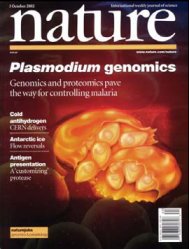
Application: The malaria parasite thrives via a complex multi-stage lifecycle. The identification of malaria-unique proteins will facilitate the design of drugs and vaccines that can effectively interrupt the parasite's life-cycle and create new strategies for controlling malaria-associated illness and death. This information will also facilitate the development of new diagnostic methods to detect malaria parasites. 
Date of completion: 3 October 2002 (Published in Volume 319 of the journal Nature). Reasons for Development: Understanding the malaria genome is key to development of new drugs, vaccines and diagnostic methods for this disease, which can render military personnel unable to fight and cause life-threatening disease. Routine use of insect repellents, insecticides and bed nets can help block infection if used routinely but do not guarantee protection. Until an effective malaria vaccine capable of providing long-term prophylaxis is available, the U.S. military must continue to develop new antimalarial drugs (a sustained effort is required because malaria parasites develop drug resistance) and improved ways of rapidly diagnosing the infection. Role of DoD: To tackle the task of sequencing the entire 26 megabase genome of P. falciparum (the largest microbial genome project at the time), the Department of Defense co-founded an international consortium consisting of three genome sequencing centers: The Institute for Genomic Research (TIGR) in association with the Naval Medical Research Center (NMRC), Stanford University, and the Sanger Center in the United Kingdom. Funding for the consortium was provided by the Department of Defense (Military Infectious Diseases Research Program), the Wellcome Trust, the National Institutes of Allergy and Infectious Diseases (NIAID) and the Burroughs-Wellcome Fund. Frequent communications via conference calls and meetings held both in the U.S. and U.K. ensured success. The research team enlisted the assistance of several research persons outside of the malaria research community, including experts in direct visualization of whole fragmented chromosomes for confirmation of sequence assembly (including Dr. David Schwartz of New York University and University of Wisconsin), experts in functional genomics and proteomics (including Dr. John Yates of the University of Washington and Scripps Research Institute), and Dr. Hamilton Smith (an expert in sequence library preparation and Nobel Laureate associated with John Hopkins University). Some members of the malaria research community voiced skepticism whether the entire genome of P. falciparum could be completed because of the known difficulty with cloning large fragments of P. falciparum DNA into standard E. coli cloning systems, (attributed to the extremely high percentage of adenines and thymines in the P. falciparum genome). A start-up grant from NIAID to The Institute of Genomic Research (TIGR) and NMRC to complete a one megabase chromosome from P. falciparum was aimed at elucidating strategies for overcoming potential cloning biases in the sequencing libraries. The TIGR/NMRC team completed sequencing of chromosome 2 and published this data in the journal Science in 1998 approximately 18 months after starting the project. These efforts also paved the way for the development of a low-cost and rapid sequencing strategy for additional Plasmodia species such as P. yoelii (used as a model for malaria vaccine development; also published 3 October 2002) and current effort on P. vivax (the second most important cause of malaria; sequence completed, annotation in progress). The publication of the P. falciparum genome has provided a basis on which to conduct comparative proteomics to identify new potential drug, vaccine and diagnostic targets and to better understand the biology of this complex protozoan parasite. Using high throughput proteomics and parallel computer processing, over 2,400 proteins were functionally characterized from four major stages of the parasite life cycle targeted for drug and vaccine development. The completion of these malaria genomes has also provided tools to track the evolution of antimalarial drug resistance. References: Anonymous. Malaria after the genome. Nature 421:97, 2003 Carlton JM, Angiuoli SV, Suh BB. Genome sequence and comparative analysis of the model rodent malaria parasite Plasmodium yoelli. Nature 419:512-519, 2002. Doolittle, RF. The parasite genome: the grand assault. Nature 419:493-4, 2002. Florens L, Washburn MP, Raine JD, et al. A proteomic view of the Plasomdoum falciparum life style. Nature 421:520-526, 2002. Gardner MJ, Hall N, Fung E et al. Geonome sequence of the human malaria parasite Plasmodium falciparum. Nature 419:498-511, 2002. Gardner MJ, Shallom SJ, Carton JM, et al. Sequence of Plasmodium falciparum chromosomes 2, 10, 11 and 14. Nature 419:531-534, 2002. Hall N, Pain A, Berriman M et al. Sequence of Plasmodium falciparum chromosomes 1, 3-9 and 13. Nature 419:527-531, 2002. Hyman RW, Fung E, Conway A, et al. Sequence of Plasmodium falciparum chromosomes 2, 10, 11, and 14. Nature 419:534-537, 2002. Lasonder E, Ishihama Y, Andersen JS et al. Analysis of the Plasmodium falciparum proteome by high-accuracy mass spectrometry .Nature 419:537-542, 2002. Wirth, DF. The parasite genome: Biological relevations. Nature 419:495-6, 2002. malaria genome info paper v05 25-Jan-06 |
| Malaria Genome |
